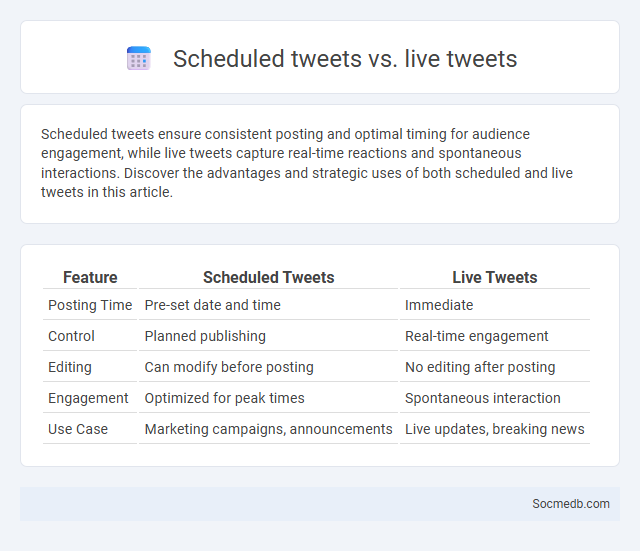
Photo illustration: Scheduled tweets vs live tweets
Scheduled tweets ensure consistent posting and optimal timing for audience engagement, while live tweets capture real-time reactions and spontaneous interactions. Discover the advantages and strategic uses of both scheduled and live tweets in this article.
Table of Comparison
| Feature | Scheduled Tweets | Live Tweets |
|---|---|---|
| Posting Time | Pre-set date and time | Immediate |
| Control | Planned publishing | Real-time engagement |
| Editing | Can modify before posting | No editing after posting |
| Engagement | Optimized for peak times | Spontaneous interaction |
| Use Case | Marketing campaigns, announcements | Live updates, breaking news |
Introduction to Scheduled Tweets, Live Tweets, and Reports
Scheduled tweets enable users to plan and automate their social media content, ensuring consistent online presence without manual posting. Live tweets capture real-time engagement during events, maximizing interaction and audience reach. Comprehensive reports analyze tweet performance, providing insights on engagement metrics, audience growth, and content effectiveness to optimize social media strategies.
Defining Scheduled Tweets: Pros and Cons
Scheduled tweets allow you to plan and automate your social media posts on platforms like Twitter, ensuring consistent content delivery without manual posting each time. The pros include improved time management, enhanced audience engagement through timely content, and the ability to maintain a regular posting schedule. However, cons involve potential loss of spontaneity, risk of outdated or irrelevant content if trends change, and limited real-time interaction with followers.
Understanding Live Tweets: Benefits and Challenges
Live tweets provide real-time updates and immediate audience engagement, enhancing event visibility and interaction on platforms such as Twitter. They enable timely sharing of information, fostering community building and instant feedback but require accurate, concise communication to maintain credibility. Challenges include managing misinformation, controlling narrative flow, and handling the rapid pace that demands constant monitoring and quick responses.
What is a Social Media Report: Key Features
A social media report is a comprehensive analysis that tracks the performance of social media campaigns and platforms by measuring key metrics such as engagement, reach, impressions, and follower growth. It includes data visualizations, trend analysis, and audience demographics to evaluate content effectiveness and inform future strategies. Essential features often comprise platform-specific insights, campaign comparisons, and recommendations for optimizing social media presence and ROI.
Comparing Scheduled vs Live Tweets: Engagement Metrics
Scheduled tweets often achieve higher engagement rates by posting at optimal times tailored to your audience's activity patterns. Live tweets generate immediate interaction through real-time relevance but may see less sustained engagement over time. Analyzing metrics like retweets, likes, replies, and click-through rates helps determine which strategy maximizes Your social media impact.
Content Planning: Which Option Suits Your Strategy?
Effective content planning on social media hinges on aligning post frequency with audience engagement patterns and platform algorithms. Analyzing metrics such as peak user activity times and content performance helps determine whether daily posts, weekly updates, or periodic campaigns best fit your strategy. Tailoring content types--videos, images, stories--to platform-specific preferences enhances visibility and drives targeted interactions.
Real-Time Relevance vs Consistent Posting
Real-time relevance on social media enhances engagement by capitalizing on trending topics, current events, and immediate audience interests, making content timely and relatable. Consistent posting establishes brand presence and reliability, fostering long-term audience retention through regular interaction regardless of trends. Balancing these strategies maximizes visibility and user connection, driving sustained growth and dynamic engagement metrics.
Tracking Performance: Reporting and Analytics
Tracking performance on social media involves analyzing key metrics such as engagement rates, click-through rates, and follower growth to understand content effectiveness and audience behavior. Utilizing advanced reporting tools like Facebook Insights, Instagram Analytics, and third-party platforms enables businesses to generate detailed reports and identify trends, which inform strategic improvements. Regularly monitoring these analytics helps optimize campaigns, enhance reach, and maximize return on investment (ROI).
Tools for Scheduling, Live Tweeting, and Reporting
Tools for social media scheduling, such as Hootsuite and Buffer, streamline content planning by enabling users to automate post timing across multiple platforms. Live tweeting tools like TweetDeck enhance real-time engagement during events by organizing tweet streams and enabling instant interaction. Reporting tools including Sprout Social provide detailed analytics on audience demographics, engagement rates, and post performance to optimize social media strategies.
Choosing the Best Approach for Your Brand
Selecting the best social media approach for your brand requires analyzing target audience demographics, platform engagement trends, and competitive landscape performance metrics. Tailoring content strategies to resonate with your unique customer personas increases brand visibility and drives meaningful interactions across channels like Instagram, LinkedIn, and TikTok. Your brand's success depends on aligning marketing goals with data-driven insights to optimize reach and conversion rates.
 socmedb.com
socmedb.com